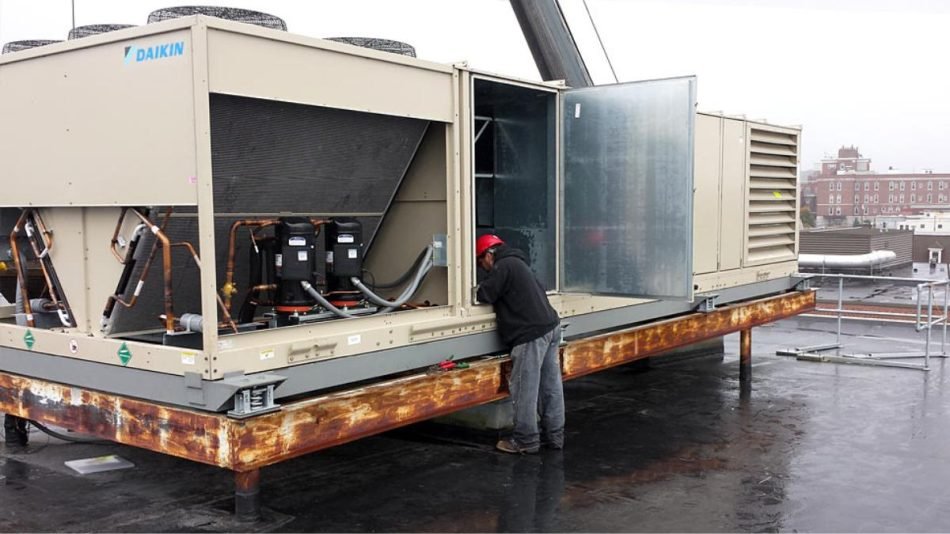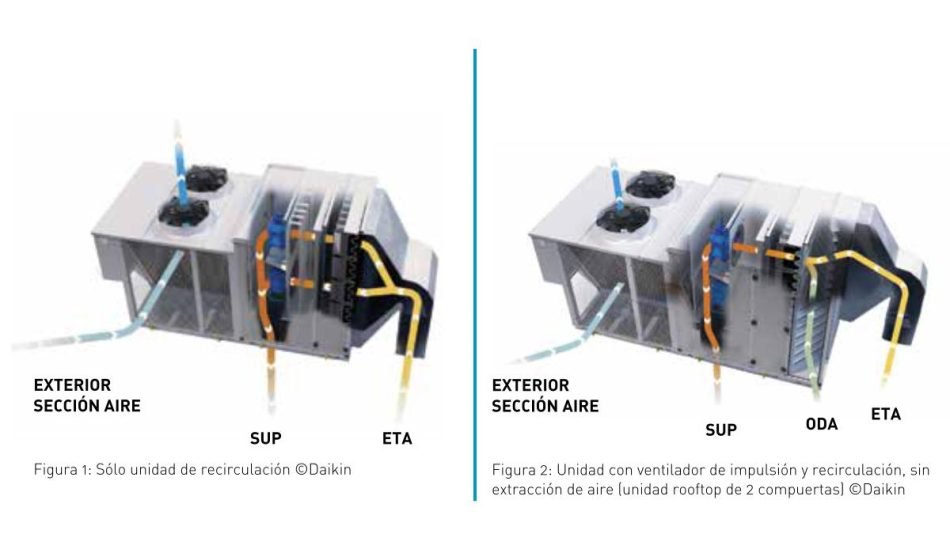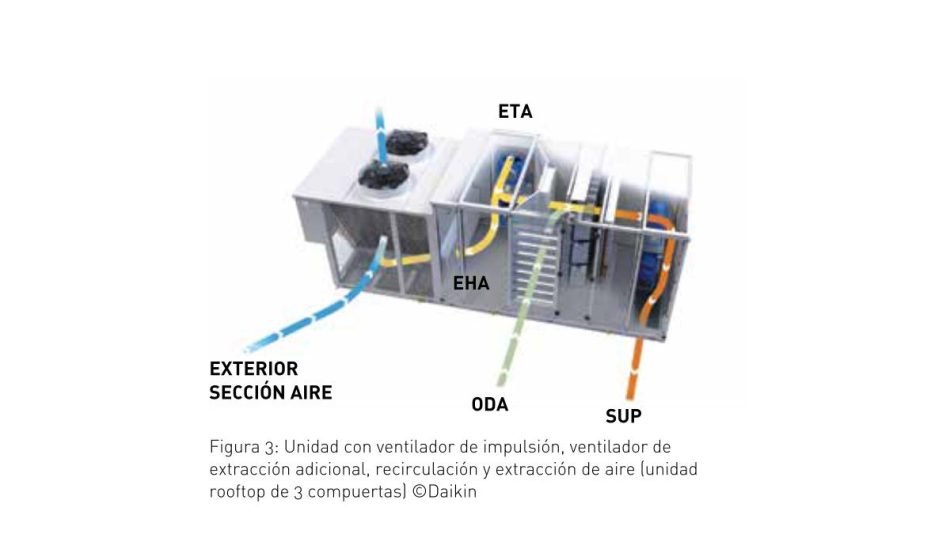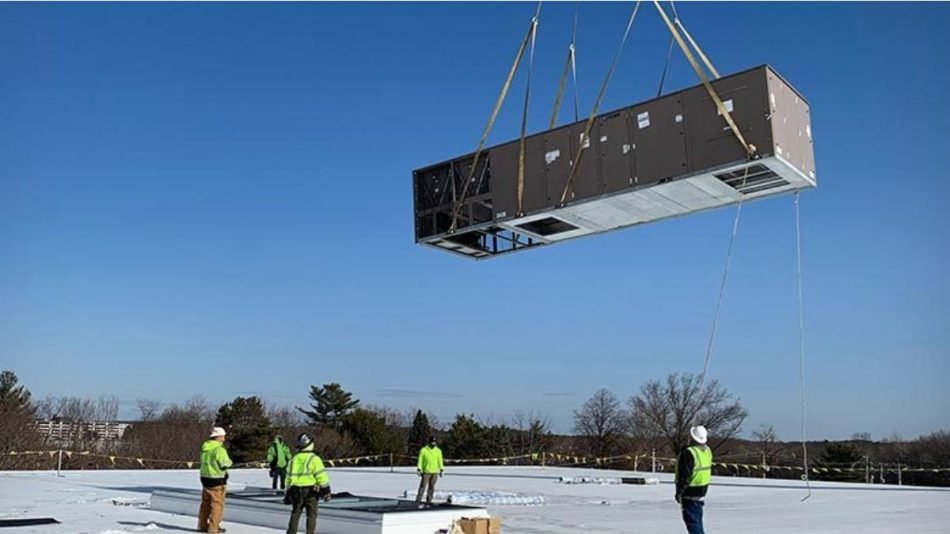HVAC Rooftop
The Vital Role of Rooftop Units and their Relevance to Our Indoor Environment
In today’s age, we spend most of our time indoors, which includes our time at work, school, stores, cafes, restaurants, cinemas, theaters, sports clubs and, of course, in our homes. This fact is especially significant when we consider that, in technical terms, indoor environmental quality (IEQ) is of paramount importance.
IEQ has a direct impact on our health, well-being and productivity, influencing work performance and children’s learning, for example. Maintaining a high IEQ implies considerable energy consumption, so it is essential that the technologies in charge of maintaining it are highly efficient, environmentally friendly and reasonable investment.
At the heart of IEQ are two main elements: thermal comfort, which encompasses adequate temperature and humidity, and indoor air quality (IAQ). Achieving optimal IAQ involves effectively renewing indoor air and adequately filtering the air. At the same time, maintaining adequate thermal comfort involves providing energy for heating and cooling. Specifically, this energy is needed to:
- Condition the outdoor air entering the building, which includes heating, cooling, and possibly humidification and dehumidification.
- Compensate for building heat gains and losses, which involve the transfer of energy through the building envelope due to temperature differences, the thermal load of electrical equipment, or solar radiation.
Rooftop units (RTU), are compact, self-contained devices that integrate all the necessary components for efficient air renewal and indoor thermal comfort, as well as the generation of cooling and heating capacity. For many building typologies and applications, rooftop units are emerging as the most suitable choice for an integrated heating, ventilation and air conditioning (HVAC) system solution instead of separate heating, cooling, ventilation and control systems. This translates into high energy efficiency, operating reliability and low investment costs. In addition, rooftop units can be equipped with high-efficiency filters that remove harmful particles from the air supplied to the building and eliminate pathogens that can cause disease in the recirculated air.
What are Rooftop Units?
To fully understand the value of rooftop units, it is important to explore their history. These systems emerged in the 1980s and, in their earliest versions, were considered basic, inexpensive HVAC options with rudimentary operation and simple components. However, technology has advanced considerably since then.
Today’s rooftop units are state-of-the-art air conditioning systems that stand out for their high energy efficiency and flexibility in adapting to operating conditions. They incorporate intelligent controls that integrate with building management systems (BMS), allowing them to configure and adjust their operations according to the climatic conditions and the environment in which they are located.

Purpose of Rooftop Units
The primary function of rooftop units is to provide cooling and heating on demand to ensure indoor thermal comfort. Those units that supply outside air also contribute significantly to maintaining adequate IAQ. These objectives can be achieved through stand-alone systems that combine various technologies, but this approach is often more complicated and costly. Rooftop units, on the other hand, simplify HVAC system design and installation due to their compact design and reduced space requirements.

The Core of the Rooftop Units
Rooftop units consist of several key elements:
- Cooling circuit: This is the most critical component of the rooftop unit and can often operate in both cooling and heating. The refrigeration circuit includes essential components such as the compressor, evaporator, condenser, expansion valve and, of course, the refrigerant.
- Fans and economizer: The section consisting of fans and an economizer is responsible for supplying outside air and heat to the space. The fans generate the airflow to distribute the heat from the refrigeration cycle and supply outside air, while the economizer allows free cooling, which reduces energy consumption. This section also incorporates air filters to purify the air supplied to the building.

Types of Rooftop Units
Rooftop units play an essential role in the circulation and conditioning of air in buildings. They can extract indoor air, mix it with outdoor air for ventilation, filter it and adjust its temperature before distributing it through ducts to specific areas of the building via fans. There are several types of rooftop units:
- Full recirculation units: These units do not supply outside air and only condition indoor air, which is suitable when ventilation is ensured by other means.
- Units with supply fan and recirculation: These units supply outdoor air but do not exhaust air, which can generate overpressure in the building. This option is suitable for buildings with low air tightness and frequently open doors.
- Units with supply fan, recirculation and air exhaust: These units are used to balance pressures in the building and can be equipped with exhaust fans to control the pressure balance.
- Units with supply fan, exhaust fan, recirculation and energy recovery: These units incorporate components to recover energy from the exhaust air, improving energy efficiency, especially in applications with a high proportion of outdoor air.



Supporting the Fight Against Climate Change and Environmental Challenges
The rooftop units are aligned with the European “Green Pact”, a strategy that aims for the European Union to achieve climate neutrality by 2050. Three key elements of this strategy are promoting heat pump technology, reducing the impact of refrigerants and promoting the circular economy.
Heat pump technology: Air-to-air heat pumps, used in rooftop units, can play a key role in reducing dependence on fossil fuels such as natural gas. These heat pumps are highly efficient and use electricity increasingly produced from renewable sources, making them an environmentally friendly alternative.
Reduced refrigerant impact: Rooftop units use low global warming potential (GWP) refrigerants to reduce F-Gas emissions and meet EU emission reduction targets.

Reasons to Use Rooftop Units
- Main advantages: Rooftop units offer comprehensive solutions ranging from thermal comfort to air quality in buildings in a single monobloc system. Thanks to their design and configurability, they can be adapted to current demand and configuration, evolving from basic HVAC systems to comprehensive systems capable of providing cooling, heating, ventilation, filtration, air purification, humidification, dehumidification and free cooling as required.
This approach simplifies HVAC system management compared to alternatives that require separate systems. Rooftop units integrate all functions and components into a single device, which improves energy efficiency by optimizing airflow control and energy use. In addition, installation of rooftop units is simpler and requires less time and cost due to their plug & play design. In addition, the elimination of intermediate fluid for energy transfer contributes to the overall energy efficiency of buildings. - Effective air renewal for proper IAQ: Rooftop units have the ability to provide the required amount of outdoor air at the correct temperature and humidity to spaces, ensuring high indoor air quality and adequate thermal comfort. These units remove pollutants and regulate indoor air temperature, which significantly improves the quality of the air we breathe indoors.
- Adequate amount of outdoor air and heat recovery to optimize energy: Rooftop units balance the amount of outdoor air with indoor air recirculation to ensure adequate IAQ and minimize energy consumption associated with outdoor air treatment. In addition, they can harness energy from the exhaust air to heat outdoor air, further reducing energy consumption.
- IAQ-integrated variable airflow and thermal comfort control: The rooftop units are equipped with variable speed drives on the motors that allow efficient control of fan performance. This facilitates the precise adaptation of air volumes to the actual needs of the building. In addition, CO2 sensors and variable air volume (VAV) devices in the ducts ensure that IAQ and temperature requirements are met in individual control zones.
- Impact on overall building energy efficiency: Because the rooftop units incorporate cooling loops, the energy generated is transferred directly to the supply air, eliminating the need for an intermediate fluid and minimizing energy losses. This contributes to improving the building’s energy efficiency. In addition, the free cooling function, a feature of many rooftop units, allows a choice between recirculating indoor air or introducing outdoor air depending on climatic conditions, which also contributes to energy efficiency.
- Easy installation: Rooftop units are characterized by their simplicity of installation, which involves connecting the unit to pre-installed ductwork and to the electrical grid. This simplifies the installation process, reduces time and associated costs, and makes it easier for installers to manage. In many cases, rooftop units are delivered fully charged with refrigerant from the factory, and can be installed on the building roof or on the ground, with ductwork located outside the building to save space. This makes rooftop units plug & play solutions that greatly simplify installation.

Rooftop units play a key role in creating comfortable and healthy indoor environments while contributing to the energy efficiency of buildings. Their ability to combine heating, cooling, ventilation and filtration in a single monobloc unit simplifies management and installation, making them a valuable option in the quest for high-quality, energy-efficient indoor environments.
Learn more about this service
Click here and find out more about our services.
Te enviaremos el artículo directamente a tu E-mail de manera instantánea.
Enviando datos, espere un momento
¡Datos enviados correctamente!
Tu mensaje será atendido en un momento
¿Desea enviar otro mensaje?
Comments
We are interested in your opinion, please leave us a comment